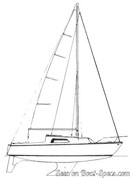Love love
Sailboat specifications
The Love love is a 21’8” (6.6m) cruising sailboat designed by Jeanneau Design Office (France). She was built between 1970 and 1979 by Jeanneau (France) with 780 hulls completed.
Love love's main features
- Model
- Love love
- Hull type
- Monohull
- Category
- Coastal cruising sailboat
- Sailboat builder
- Sailboat designer
- Country
- France
- Construction
- Hull and deck: GRP (glass reinforced polyester)
- Number of hulls built
- 780
- First built hull
- 1970
- Last built hull
- 1979
- Appendages
- Keel : fin without bulb
- Helm
- Single tiller
- Rudder
- Single semi-spade rudder
- Unsinkable
- No
- Trailerable
- Yes
- Former French navigation category
- 3
- Standard public price ex. VAT (indicative only)
- N/A €
Love love's main dimensions
- Hull length
- 21’ 8”6.6 m
- Waterline length
- 18’ 6”5.65 m
- Beam (width)
- 8’2.45 m
- Draft
- 3’ 5”1.05 m
- Mast height from DWL
- 33’ 6”10.2 m
- Light displacement (MLC)
- 2646 lb1200 kg
- Ballast weight
- 1036 lb470 kg
- French customs tonnage
- 3.43 Tx
Love love's rig and sails
- Upwind sail area
- 269 ft²25 m²
- Downwind sail area
- 441 ft²41 m²
- Mainsail area
- 118 ft²11 m²
- Genoa area
- 151 ft²14 m²
- Jib area
- 91 ft²8.5 m²
- Stormjib area
- 43 ft²4 m²
- Symmetric spinnaker area
- 323 ft²30 m²
- Rigging type
- Sloop Marconi masthead
- Mast configuration
- Deck stepped mast
- Rotating spars
- No
- Number of levels of spreaders
- 1
- Spreaders angle
- 0 °
- Spars construction
- Aluminum spars
- Standing rigging
- 1x19 strand wire
Love love's performances
- Upwind sail area to displacementiThe ratio sail area to displacement is obtained by dividing the sail area by the boat's displaced volume to the power two-thirds.
The ratio sail area to displacement can be used to compare the relative sail plan of different sailboats no matter what their size.
Upwind: under 18 the ratio indicates a cruise oriented sailboat with limited performances especially in light wind, while over 25 it indicates a fast sailboat. - 238 ft²/T22.14 m²/T
- Downwind sail area to displacementiThe ratio sail area to displacement is obtained by dividing the sail area by the boat's displaced volume to the power two-thirds.
The ratio sail area to displacement can be used to compare the relative sail plan of different sailboats no matter what their size. - 391 ft²/T36.31 m²/T
- Displacement-length ratio (DLR)iThe Displacement Length Ratio (DLR) is a figure that points out the boat's weight compared to its waterline length. The DLR is obtained by dividing the boat's displacement in tons by the cube of one one-hundredth of the waterline length (in feet).
The DLR can be used to compare the relative mass of different sailboats no matter what their length:
a DLR less than 180 is indicative of a really light sailboat (race boat made for planning), while a DLR greater than 300 is indicative of a heavy cruising sailboat. - 188
- Ballast ratioiThe Ballast ratio is an indicator of stability; it is obtained by dividing the boat's displacement by the mass of the ballast. Since the stability depends also of the hull shapes and the position of the center of gravity, only the boats with similar ballast arrangements and hull shapes should be compared.
The higher the ballast ratio is, the greater is the stability. - 39 %
- Critical hull speediAs a ship moves in the water, it creates standing waves that oppose its movement. This effect increases dramatically the resistance when the boat reaches a speed-length ratio (speed-length ratio is the ratio between the speed in knots and the square root of the waterline length in feet) of about 1.2 (corresponding to a Froude Number of 0.35) . This very sharp rise in resistance, between speed-length ratio of 1.2 to 1.5, is insurmountable for heavy sailboats and so becomes an apparent barrier. This leads to the concept of "hull speed".
The hull speed is obtained by multiplying the square root of the waterline length (in feet) by 1.34. - 5.77 knots
Love love's auxiliary engine
- Engine(s)
- Outboard engine
Love love's accommodations and layout
- Cockpit
- Closed aft cockpit
- Cabin(s)
- 1
- Berth(s) (min./max.)
- 2 / 5
- Maximum headroom
- 4’ 11”1.5 m
Love love's saloon
- Berth length
- 6’ 2”1.9 m
- Chart table
- 2’ 7”0.8 m x 1’ 10”0.56 m
- Berth width
- 2’0.6 m
Love love's fore cabin
- Berth length
- 7’ 2”2.2 m
- Berth width
- 6’ 2”1.9 m










Jeanneau Love love interior and accommodations - - 9/9
Picture extracted from the commercial documentation © Jeanneau
Picture extracted from the commercial documentation © Jeanneau
Similar sailboats that may interest you:
Sailboats
First built hull
Hull length
1985
23’ 7”7.2 m
1966
23’ 4”7.1 m
1995
21’ 6”6.55 m
1985
22’ 7”6.9 m
1961
22’ 7”6.9 m
1982
24’ 7”7.5 m
2005
24’ 6”7.47 m
1976
19’ 8”6 m
1978
19’ 8”6 m
1973
20’ 4”6.2 m
1974
20’ 4”6.2 m
1977
23’ 7”7.2 m
1978
21’ 6”6.55 m
1979
19’ 8”6 m
1979
24’ 11”7.6 m